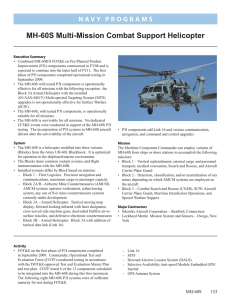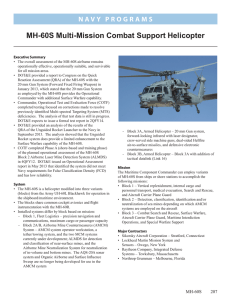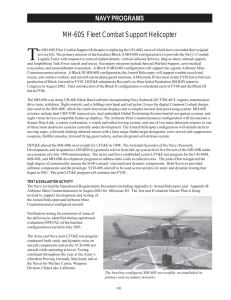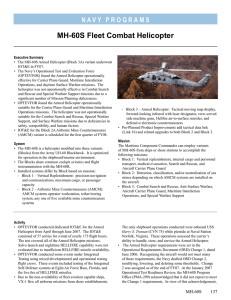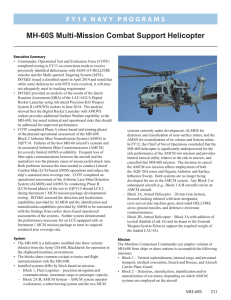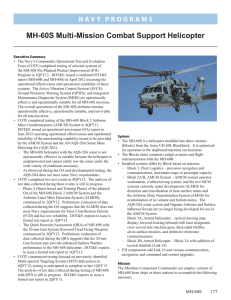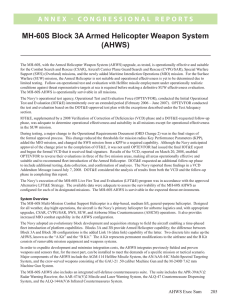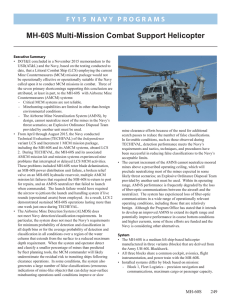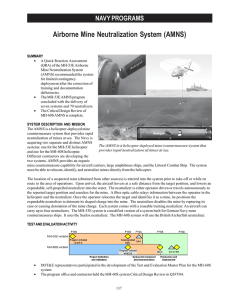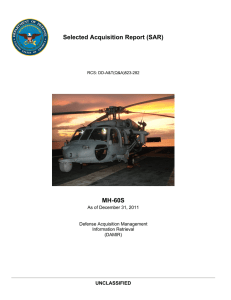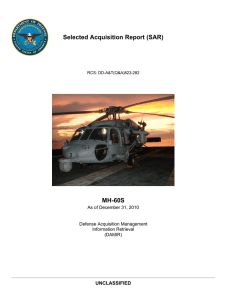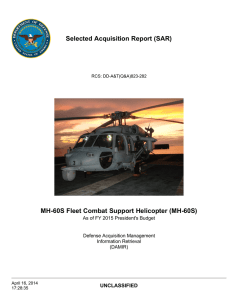MH-60S Multi-Mission Combat Support Helicopter
advertisement
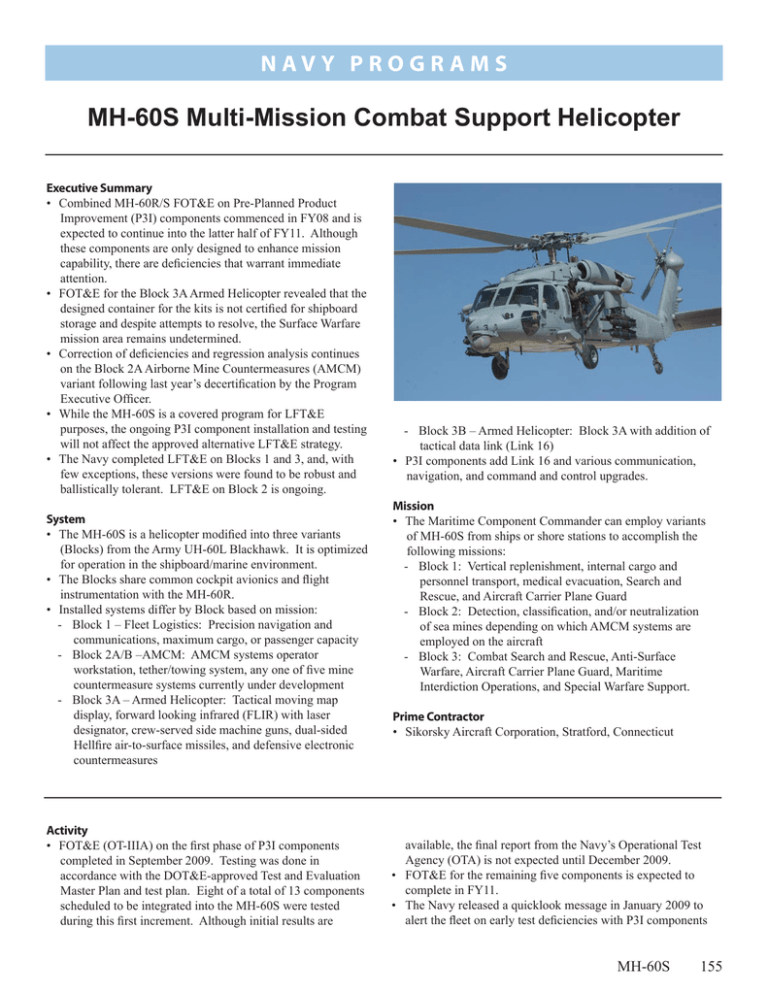
N a v y P ROGRA M S MH-60S Multi-Mission Combat Support Helicopter Executive Summary • Combined MH-60R/S FOT&E on Pre-Planned Product Improvement (P3I) components commenced in FY08 and is expected to continue into the latter half of FY11. Although these components are only designed to enhance mission capability, there are deficiencies that warrant immediate attention. • FOT&E for the Block 3A Armed Helicopter revealed that the designed container for the kits is not certified for shipboard storage and despite attempts to resolve, the Surface Warfare mission area remains undetermined. • Correction of deficiencies and regression analysis continues on the Block 2A Airborne Mine Countermeasures (AMCM) variant following last year’s decertification by the Program Executive Officer. • While the MH-60S is a covered program for LFT&E purposes, the ongoing P3I component installation and testing will not affect the approved alternative LFT&E strategy. • The Navy completed LFT&E on Blocks 1 and 3, and, with few exceptions, these versions were found to be robust and ballistically tolerant. LFT&E on Block 2 is ongoing. System • The MH-60S is a helicopter modified into three variants (Blocks) from the Army UH-60L Blackhawk. It is optimized for operation in the shipboard/marine environment. • The Blocks share common cockpit avionics and flight instrumentation with the MH-60R. • Installed systems differ by Block based on mission: - Block 1 – Fleet Logistics: Precision navigation and communications, maximum cargo, or passenger capacity - Block 2A/B –AMCM: AMCM systems operator workstation, tether/towing system, any one of five mine countermeasure systems currently under development - Block 3A – Armed Helicopter: Tactical moving map display, forward looking infrared (FLIR) with laser designator, crew-served side machine guns, dual-sided Hellfire air-to-surface missiles, and defensive electronic countermeasures Activity • FOT&E (OT-IIIA) on the first phase of P3I components completed in September 2009. Testing was done in accordance with the DOT&E-approved Test and Evaluation Master Plan and test plan. Eight of a total of 13 components scheduled to be integrated into the MH-60S were tested during this first increment. Although initial results are - Block 3B – Armed Helicopter: Block 3A with addition of tactical data link (Link 16) • P3I components add Link 16 and various communication, navigation, and command and control upgrades. Mission • The Maritime Component Commander can employ variants of MH-60S from ships or shore stations to accomplish the following missions: - Block 1: Vertical replenishment, internal cargo and personnel transport, medical evacuation, Search and Rescue, and Aircraft Carrier Plane Guard - Block 2: Detection, classification, and/or neutralization of sea mines depending on which AMCM systems are employed on the aircraft - Block 3: Combat Search and Rescue, Anti-Surface Warfare, Aircraft Carrier Plane Guard, Maritime Interdiction Operations, and Special Warfare Support. Prime Contractor • Sikorsky Aircraft Corporation, Stratford, Connecticut available, the final report from the Navy’s Operational Test Agency (OTA) is not expected until December 2009. • FOT&E for the remaining five components is expected to complete in FY11. • The Navy released a quicklook message in January 2009 to alert the fleet on early test deficiencies with P3I components MH-60S 155 N a v y P ROGRA M S • • • • selected to support an early deployment with Carrier Strike Group THREE. OT-IIIA included some Block 3A Armed Helicopter FOT&E events to include aircraft carrier (CVN) shipboard compatibility and attempts to resolve the undetermined surface warfare (SUW) mission assessment. In September 2009, the Navy’s OTA submitted a MH-60S P3I Anomaly Report, a recourse to provide timely test failure and/or deficiency information to the Program Office. Correction of deficiencies to include some redesign of critical components in the Block 2 AMCM variant, designed primarily to support systems that are part of the new Littoral Combat Ship (LCS) Mine Countermeasures Mission Package, is ongoing. Developmental testing on Block 2A with the AQS‑20A sonar is scheduled to recommence 1QFY10 with IOT&E in June 2010. The MH-60S is a covered system for LFT&E. LFT&E has been completed on Blocks 1 and 3, and, with few exceptions, these versions were found to be robust and ballistically tolerant. LFT&E on Block 2 is ongoing. Assessment • An OT-IIIA interim report submitted by the Navy’s OTA in February 2009 assessed the MH-60S with Link 16 incorporated (Block 3B) as operationally effective and suitable. The report expedited a fleet introduction recommendation and facilitated deployment of the MH-60S with a new software system configuration in January 2009, prior to the final FOT&E report. • The addition of Link 16 receive-only capability has increased MH-60S crew situational awareness of the maritime picture; however, OT-IIIA highlighted some significant deficiencies: - In-flight free text messaging is not available to respond to participating units. The crew is limited to using preformatted permission configured text messages. - The mission tasking function causes false indications to other participants and is prohibited from use during fleet flight clearance. - To date, no tactics have been published to incorporate Link 16 functionality into missions. - Joint “J” Voice, the primary Link 16 coordination net, is unavailable to aircrew in the cabin, requiring pilots to relay mission critical information via the internal net, further increasing the workload. This risks a breakdown in coordination and severely jeopardizes mission accomplishment. - A live video downlink via the imagery net is not available. The MH-60S is limited to exchanging only still frame imagery. - MH-60 Link 16 training is inadequate. Although a formal Navy course is being developed, the operators did not effectively understand nor demonstrate proficiency in operating the system. - There is no Naval Air Training and Operating Procedures Standardization (NATOPS) manual to support effective use of the MH-60S with Link 16. 156 MH-60S • The Automatic Video Tracking (AVT) feature of the Multi‑Spectral Targeting System (MTS) FLIR fails to meet tracking and engagement thresholds. The MTS failed to successfully engage threat representative high-speed targets with Hellfire missiles because the AVT failed to maintain lock with the auto-tracker. Attempts to manually track the target to provide terminal guidance proved too challenging. • The Downed Aircrew Locator System (DALS) is rendered ineffective due to: - The MH-60S incompatibility with the Combat Survivor Evader Locater (CSEL) radio, the current survival radio employed by all Naval aviators. - The failure to receive Quickdraw messages, providing time-critical survivor information during terminal phase of the rescue. • APX-118 Elementary Mode-S surveillance capability (providing an aircraft-unique 24-bit address identifier) is not certified and Mode-S Level 2 enhanced surveillance information fails to meet the threshold by not transmitting accurate track angle rate to traffic controllers. • Block 3A Armed Helicopter Weapons System (AHWS) FOT&E during OT-IIIA revealed: - The ISU-90 container designed for package, handling, storage, and transportation of one entire AHWS kit is not certified for at-sea shipboard storage. All six containers assigned to the deploying squadron (HSC-8) were not permitted onboard USS Stennis (CVN 74), forcing the crew to store components not being used on pallets or on the hangar floor exposed to inadvertent damage. - The SUW mission remains undetermined. Two attempts at engaging high-speed, operationally realistic, evasive maneuvering targets with Hellfire missiles both during the day and at night surfaced the AVT failure to maintain lock. Both Hellfire missiles expended missed their intended targets. • The Block 2 AMCM variant continues to struggle with the Carriage, Stream, Tow, and Recovery System (CSTARS) reliability. Additional testing with the AQS-20A revealed that the tow cable has a tendency to become tangled on the drum during periods of low tension and cable fairing damage caused by fitting interference still persists. A reliable CSTARS is essential to enable organic mine detection and neutralization. Recommendations • Status of Previous Recommendations. The Navy has addressed two of the eight FY07 and FY08 recommendations. The remaining recommendations are still valid. • FY09 Recommendations. The Navy should: 1. Develop a plan to expeditiously correct Link 16 deficiencies to lessen the impact on deploying squadrons. 2. Pursue a correction to the AVT feature of the MTS (FLIR) to increase the probability of a successful Hellfire engagement of a smaller, high-speed maneuvering vessel. 3. Provide the MH-60S interoperability with the CSEL survival radio and Quickdraw so that DALS can be N a v y P ROGRA M S effectively utilized and enable the aircraft to successfully execute its Combat Search and Rescue mission. 4. Obtain a certification for elementary Mode-S and resolve the deficiency with the Level 2 enhanced surveillance to comply with new air traffic regulations and increase safety of flight. 5. Develop a plan to allow safe shipboard storage of Block 3A AHWS kit components when not installed and in use on the aircraft to include shipboard certification of a package, handling, storage, and transportation container. 6. Conduct additional FOT&E to demonstrate Block 3A AHWS operational effectiveness in the SUW mission. 7. Continue to pursue improved CSTARS reliability and software upgrades to enable the Block 2 variant capable of conducting successful organic Airborne Mine Countermeasure operations. MH-60S 157 N a v y P ROGRA M S 158
